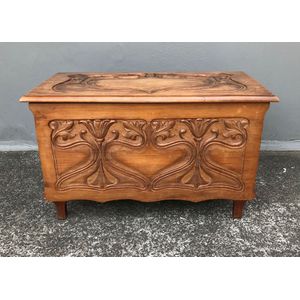Art Nouveau Rimu Blanket Box with Whiplash Carvings
You must be a subscriber, and be logged in to view price and dealer details.
Subscribe Now to view actual auction price for this item
When you subscribe, you have the option of setting the currency in which to display prices to $Au, $US, $NZ or Stg.
- Scallop / Shell Motif - The shell motif has been used in furniture and decorative arts for centuries. In ancient Greece and Rome, shells were often used as decorative elements on furniture and in mosaics. The scallop or cockleshell are the most commonly used. During the Renaissance, the shell motif became popular in furniture and architecture, as the ornate decoration was seen as a symbol of wealth and luxury. In the 18th century, the Rococo style of furniture and decorative arts featured an abundance of shell motifs, and it was used by Thomas Chippendale and as a feature on Queen Anne style cabriole legs. In the 19th century, the shell motif was incorporated into Victorian furniture and decorative items, and often a representation of the the conch shell was inlaid into furniture.
- Art Nouveau Period - The Art Nouveau period was a cultural movement that emerged in the late 19th century, and was characterized by its emphasis on natural forms, flowing lines, and a decorative, ornamental style. Art Nouveau was a reaction against the ornate and heavily stylized designs of the previous era, and sought to create a new, more organic aesthetic.
Art Nouveau was characterized by its use of sinuous, curving lines, as well as a focus on natural elements such as flowers, vines, and other organic shapes. Art Nouveau designers sought to create a total work of art, in which every element of a building or object was designed to be harmonious with the overall design.
Some of the most iconic examples of Art Nouveau design include the Paris Metro entrances designed by Hector Guimard, the works of the artist Alphonse Mucha, and the architecture of Victor Horta in Brussels.
The Art Nouveau period was at its peak between 1890 and 1910, but began to decline in popularity by the start of World War I. However, Art Nouveau remains an important influence on design and art to this day, and continues to be celebrated for its emphasis on natural forms and decorative style.
This item has been included into following indexes:
Visually similar items

A rare Florentine walnut and gilt cassone, Italian, late 15th/16th century. 71 cm high, 175 cm wide, 58 cm deep. Note: 'Italian Cassoni, from the Art Collections of Soviet Museums by Aurora Art Publishers. Leningrad' plates 68-72 for almost identical casso

A Louis XV style escritoire the bombe body inlaid with multiple parquetry panels, centred by a fall-front writing surface, a frieze drawer and three lower drawers, marble top, 93 x 149.5 x 40 cm

An 18th century oak coffer with relief carved frieze and panels centred by initials 'EB' flanked by opposing dragons; the central armorial panel flanked by coin-moulded stiles. Width 135 cm

A large dowry storage chest on a wheeled base, carved with a floral design, 20th century, the lid opening back & sectioned inside, 68 x 130 x 60 cm
